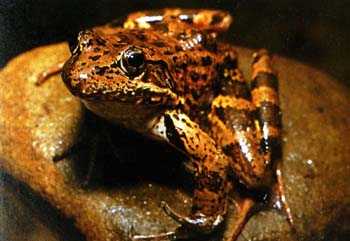![[Metroactive News&Issues]](http://metroactive.com/gifs/news468.gif)
[ San Jose | Metroactive Central | Archives ]
Leap of Faith
It will take study to figure out exactly how to bring back the California red-legged frog
By Jim Rendon
RED-LEGGED FROGS were once everywhere in California. Jim Smiley, in Mark Twain's short story "The Celebrated Jumping Frog of Calveras County," had no trouble digging a few of them out of a local swamp in California's gold country. But today the famous leaper survives in only a few of the state's 52 counties.
During the gold rush, red-legged frogs were hunted to scarcity for their appetizing legs. Gold miners also brought along bullfrogs, which, though related to the native frog, did not exist here naturally. The larger bullfrogs out-competed their red-legged cousins in the food quest, and even turned to eating their young. The red-legged frog has never really recovered.
Though it's almost completely gone from the Central Valley and the Sierra, there are still creeks and ponds in Santa Clara County that support Twain's jumping frog, mostly along the eastern and western hills where development is prohibited.
Stretched out from foot to head, the frogs are a little less than a foot long, and they get their name from the reddish markings on their backs and undersides.
The frogs spend the wet part of the year in ponds or streams, where they lay eggs. Then, when summer rolls around, they take off, sometimes heading a mile or more over land. They often settle in for the summer along creeks, or sometimes in trees. Dense vegetation along small streams provides some of the best frog habitat.
But scientists are still learning a lot about the frog, says David Wright, a biologist with the U.S. Fish and Wildlife Service. He says that one frog baffled a team of biologists at the Point Reyes National Seashore when they monitored its summer retreat. For some reason, it spent a portion of the dry season happy as could be in the middle of an open grassy field, far from the nearest water supply.
Because it needs a lot of varied territory--not only a pond, but also miles of grassland and creeks--the frog has run into trouble. It has disappeared from nearly 70 percent of its range in California. The population on the Santa Rosa plateau in Riverside County crashed from several hundred animals to just two males in a decade. Farming in the Central Valley, development and the introduction of new foreign species have helped to push the frog close to extinction.
[ San Jose | Metroactive Central | Archives ]
Copyright © 1999 Metro Publishing Inc. Metroactive is affiliated with the Boulevards Network.
For more information about the San Jose/Silicon Valley area, visit sanjose.com.
![]()

Photograph by George Sakkestad
Name: Rana aurora draytonii
Status: Threatened
Natural Habitat: Ponds and streams throughout much of California
Last Stand Here: Small creeks in the eastern and western hills, especially the largely undeveloped Diablo range
Reason for Demise: Sprawl, road-building and golf course development
From the November 24-December 1, 1999 issue of Metro, Silicon Valley's Weekly Newspaper.